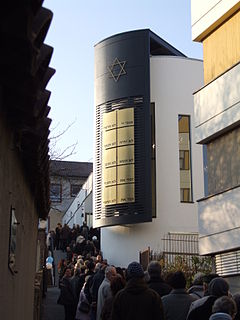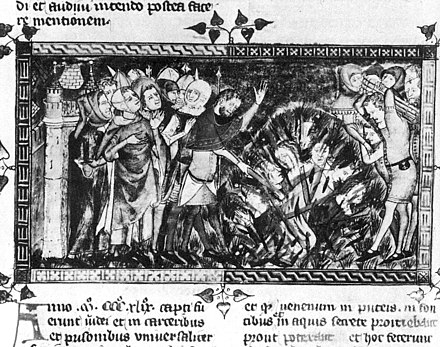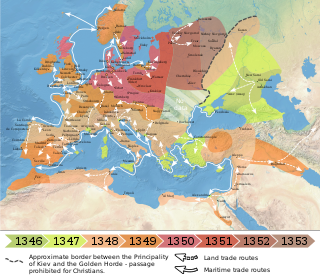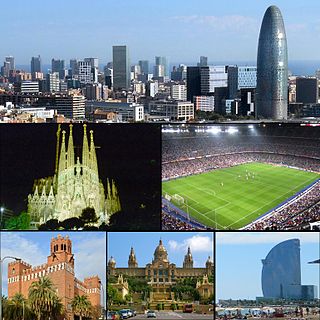Antisemitism is hostility to, prejudice, or discrimination against Jews. A person who holds such positions is called an antisemite. Antisemitism is generally considered to be a form of racism.
Blood libel or ritual murder libel is an antisemitic canard accusing Jews of murdering Christian children in order to use their blood as part of religious rituals. Historically, these claims—alongside those of well poisoning and host desecration—have been a major theme of the persecution of Jews in Europe.
Antisemitism in Christianity is the hostility of Christian Churches, Christian groups, and by Christians in general to Judaism and the Jewish people.
Year 1349 (MCCCXLIX) was a common year starting on Thursday of the Julian calendar.

A pogrom is a violent riot aimed at the massacre or persecution of an ethnic or religious group, particularly one aimed at Jews. The Russian term originally entered the English language in order to describe 19th and 20th century attacks on Jews in the Russian Empire. Similar attacks against Jews at other times and places also became retrospectively known as pogroms. The word is now also sometimes used to describe publicly sanctioned purgative attacks against non-Jewish ethnic or religious groups. The characteristics of a pogrom vary widely, depending on the specific incidents, at times leading to, or culminating in, massacres.
The history of antisemitism, defined as hostile actions or discrimination against Jews as a religious or ethnic group, goes back many centuries, with antisemitism being called "the longest hatred". Jerome Chanes identifies six stages in the historical development of antisemitism:
- Pre-Christian anti-Judaism in Ancient Greece and Rome which was primarily ethnic in nature
- Christian antisemitism in antiquity and the Middle Ages which was religious in nature and has extended into modern times
- Muslim antisemitism which was—at least in its classical form—nuanced, in that Jews were a protected class
- Political, social and economic antisemitism of Enlightenment and post-Enlightenment Europe which laid the groundwork for racial antisemitism
- Racial antisemitism that arose in the 19th century and culminated in Nazism
- Contemporary antisemitism which has been labeled by some as the new antisemitism
Religious antisemitism is aversion to or discrimination against Jews as a whole based on religious beliefs, false claims against Judaism and religious antisemitic canards. It is sometimes called theological antisemitism.
Persecution of Jews has been a major part of Jewish history, prompting shifting waves of refugees throughout the diaspora communities.

The history of the Jews in Germany goes back to the Early Middle Ages and High Middle Ages when Jewish settlers founded the Ashkenazi Jewish community. The community survived under Charlemagne, but suffered during the Crusades. Accusations of well poisoning during the Black Death (1346–53) led to mass slaughter of German Jews and they fled in large numbers to Poland. The Jewish communities of the cities of Mainz, Speyer and Worms became the center of Jewish life during Medieval times. "This was a golden age as area bishops protected the Jews resulting in increased trade and prosperity." The First Crusade began an era of persecution of Jews in Germany. Entire communities, like those of Trier, Worms, Mainz and Cologne, were murdered. The war upon the Hussite heretics became the signal for renewed persecution of Jews. The end of the 15th century was a period of religious hatred that ascribed to Jews all possible evils. The atrocities during the Khmelnytsky Uprising committed by Khmelnytskyi's Cossacks drove the Polish Jews back into western Germany. With Napoleon's fall in 1815, growing nationalism resulted in increasing repression. From August to October 1819, pogroms that came to be known as the Hep-Hep riots took place throughout Germany. During this time, many German states stripped Jews of their civil rights. As a result, many German Jews began to emigrate.
The Basel massacre of Jews took place on 9 January 1349, as part of the Black Death persecutions of 1348–1350.

The history of the Jews in Europe stretches back over two thousand years, at least. Some Jews, a Judaean Israelite tribe from the Levant, migrated to Europe just before the rise of the Roman Empire. A notable early event in the history of the Jews in the Roman Empire was Pompey's conquest of the East beginning in 63 Before Common Era (BCE), although Alexandrian Jews had migrated to Rome before this event.

The consequences of the Black Death are short and long-term effects of the Black Death on human populations across the world. They include a series of various biological, social, economic, political and religious upheavals which had profound effects on the course of world history, especially European history. Often referred to as simply "The Plague", the Black Death was one of the most devastating pandemics in human history, peaking in Europe between 1348 and 1350 with an estimated one-third of the continent's population ultimately succumbing to the disease. Historians estimate that it reduced the total world population from 475 million to between 350 and 375 million. In most parts of Europe, it took nearly 80 years for population sizes to recover, and in some areas more than 150 years.
Antisemitism in the history of the Jews in the Middle Ages became increasingly prevalent in the Late Middle Ages . Early instances of pogroms against Jews are recorded in the context of the First Crusade. Expulsion of Jews from cities and instances of blood libel become increasingly common in the 13th to 15th centuries. This trend peaked only after the end of the medieval period, and subsided only with Jewish emancipation in the late 18th to 19th century.[]
Antisemitic canards are unfounded rumors or false allegations that are defamatory towards Judaism as a religion, or defamatory towards Jews as an ethnic or religious group. Since at least the Middle Ages they often form part of broader Jewish conspiracy theories.
This timeline of antisemitism chronicles the facts of antisemitism, hostile actions or discrimination against Jews as a religious or ethnic group. It includes events in the history of antisemitic thought, actions taken to combat or relieve the effects of antisemitism, and events that affected the prevalence of antisemitism in later years. The history of antisemitism can be traced from ancient times to the present day.

The Strasbourg massacre occurred on February 14, 1349, when several hundred Jews were publicly burnt to death, and the rest of them expelled from the city as part of the Black Death persecutions. It was one of the first and worst pogroms in pre-modern history.

The history of the Jews in Speyer reaches back over 1,000 years. In the Middle Ages, the city of Speyer, Germany, was home to one of the most significant Jewish communities in the Holy Roman Empire. Its significance is attested to by the frequency of the Ashkenazi Jewish surname Shapiro/Shapira and its variants Szpira/Spiro/Speyer. After many ups and downs throughout history, the community was totally wiped out in 1940 during the Holocaust. With the fall of the Iron Curtain in 1989 Jews again settled in Speyer and a first assembly took place in 1996.
Antisemitism in the Russian Empire included numerous pogroms and the designation of the Pale of Settlement, from which Jews were forbidden to migrate into the interior of Russia, unless they converted to the Russian Orthodox state religion.
The Erfurt massacre refers to the massacre of the Jewish community in Erfurt, Germany, on March 21, 1349. Accounts of the number of Jews killed in the massacre vary widely from between 100 to up to 3000. Some Jews set fire to their homes and possessions and perished in the flames before they could be lynched. The many Black Death persecutions and massacres that occurred in France and Germany at that time were sometimes in response to accusations that the Jews were responsible for outbreaks of the Black Death, and other times justified with the belief that killing the local Jews would prevent the spread of the Black Death to that locale. Although these beliefs, and the accompanying massacres, were frequently encouraged by local bishops or itinerant Flagellants, the Catholic Church, including Pope Clement VI under whom the Flagellants and the Black Death began, and his successor, Innocent VI, were firmly against it. In a papal bull condemning the Flagellant movement in late 1349, Pope Clement VI criticized their "shedding the blood of Jews". Erfurt later suffered the ravages of the Black Plague, where over 16,000 residents died during a ten-week period in 1350.
















